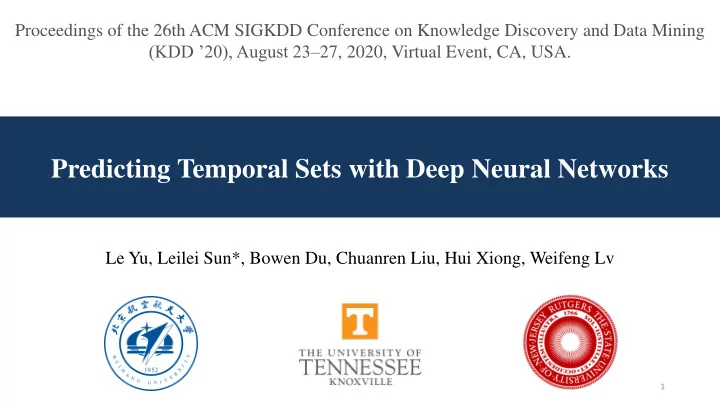

Proceedings of the 26th ACM SIGKDD Conference on Knowledge Discovery and Data Mining (KDD ’20), August 23– 27, 2020, Virtual Event, CA, USA. Predicting Temporal Sets with Deep Neural Networks Le Yu, Leilei Sun*, Bowen Du, Chuanren Liu, Hui Xiong, Weifeng Lv 1
CONTENTS Background 01 Formalization 02 03 Motivation 04 Methodology Experiments 05 2
Background 3
Background Baskets in shopping Drugs in healthcare Places in traveling Courses in schools 4
Related Work Existing methods usually follow a two-stage strategy (Yu et al. 2016, Hu and He, 2019): (1) set embedding (2) sequential behaviors learning Information loss The two-stage approach often leads to information loss. 5
A unique perspective Existing methods: Sequential Behaviors + Set Embedding Learning Lead to information loss How would the model perform if we make prediction of temporal sets from a different perspective? This work: Learning the relationship of elements Leverage information in elements relationship as much as possible 6
Formalization ⚫ L et 𝕍 = 𝑣 1 , 𝑣 2 , ⋯ , 𝑣 𝑜 , 𝕎 = {𝑤 1 , 𝑤 2 , ⋯ , 𝑤 𝑛 } denote the set of 𝑜 users and 𝑛 elements, a set 𝑇 ⊂ 𝕎 denotes the collection of elements. 𝑈 that records the 1 , 𝑇 𝑗 2 , ⋯ , 𝑇 𝑗 ⚫ Given : a sequence of sets 𝕋 𝑗 = 𝑇 𝑗 historical behaviors of user 𝑣 𝑗 ∈ 𝕍 ⚫ Goal : predict the next-period set of 𝑣 𝑗 , 𝑈+1 = 𝑔 𝑇 𝑗 መ 1 , 𝑇 𝑗 2 , ⋯ , 𝑇 𝑗 𝑈 , 𝑿 , 𝑇 𝑗 where 𝑿 is the trainable parameter. 7
Our Method: DNNTSP Fuse static and dynamic information by a gated updating mechanism Learn temporal dependencies of elements in the sequence of sets Learn set-level element relationship 8
Element Relationship Learning Learn element relationship in the same set. 1) Weighted Graphs Construction 𝑤 𝑗,1 , 𝑤 𝑗,2 , 𝑤 𝑗,1 , 𝑤 𝑗,3 , 𝑤 𝑗,1 , 𝑤 𝑗,2 , 2 , 𝑤 𝑗,1 , 𝑤 𝑗,2 , 0.67 , 𝑤 𝑗,2 , 𝑤 𝑗,1 , 𝑤 𝑗,2 , 𝑤 𝑗,3 , 𝑤 𝑗,1 , 𝑤 𝑗,3 , 3 , 𝑤 𝑗,1 , 𝑤 𝑗,3 , 1.0 , 𝑤 𝑗,3 , 𝑤 𝑗,1 , (𝑤 𝑗,3 , 𝑤 𝑗,2 ) 𝑤 𝑗,1 , 𝑤 𝑗,4 , 1 , 𝑤 𝑗,1 , 𝑤 𝑗,4 , 0.33 , 𝑤 𝑗,2 , 𝑤 𝑗,1 , 2 , 𝑤 𝑗,2 , 𝑤 𝑗,1 , 0.67 , … … … … … 𝑤 𝑗,1 , 𝑤 𝑗,1 , 1 , 𝑤 𝑗,1 , 𝑤 𝑗,1 , 0.33 , 𝑤 𝑗,1 , 𝑤 𝑗,3 , 𝑤 𝑗,1 , 𝑤 𝑗,4 , 𝑤 𝑗,2 , 𝑤 𝑗,2 , 1 , 𝑤 𝑗,2 , 𝑤 𝑗,2 , 0.33 , 𝑤 𝑗,3 , 𝑤 𝑗,1 , 𝑤 𝑗,3 , 𝑤 𝑗,4 , 𝑤 𝑗,3 , 𝑤 𝑗,3 , 1 , 𝑤 𝑗,3 , 𝑤 𝑗,3 , 0.33 , 𝑤 𝑗,4 , 𝑤 𝑗,1 , (𝑤 𝑗,4 , 𝑤 𝑗,3 ) 𝑤 𝑗,4 , 𝑤 𝑗,4 , 1 𝑤 𝑗,4 , 𝑤 𝑗,4 , 0.33 ( a ) ( b ) ( c ) ( d ) 2) Weighted Convolutions on Dynamic Graphs 𝑢,𝑚+1 = 𝜏 𝒄 𝑚 + 𝑢 𝑘, 𝑙 · 𝑿 𝑚 𝒅 𝑗,𝑙 𝑢,𝑚 𝒅 𝑗,𝑘 𝐵 𝑗 𝑢 ∪{𝑘} 𝑙∈𝒪 𝑗,𝑘 trainable convolutional parameters 9
Attention-based Temporal Dependency Learning Learn element temporal dependency among the sequence of sets. T 𝑫 𝑗,𝑘 𝑿 𝑟 𝑫 𝒋,𝑘 𝑿 𝑙 𝒂 𝑗,𝑘 = 𝑡𝑝𝑔𝑢𝑛𝑏𝑦 + 𝑵 𝑗 ⋅ (𝑫 𝑗,𝑘 𝑿 𝑤 ) 𝐺 ′′ 𝑢,𝑢 ′ = ቊ 0, 𝑗𝑔 𝑢 ≤ 𝑢′ 𝑁 𝑗 −∞, 𝑝𝑢ℎ𝑓𝑠𝑥𝑗𝑡𝑓 is a masked matrix. T T · 𝒂 𝑗,𝑘 𝒜 𝑗,𝑘 = 𝒂 𝑗,𝑘 · 𝒙 𝑏 a trainable parameter to learn the importance of different timestamps 10
Gated Information Fusing Mine shared patterns and fuse static and dynamic representations of elements. 𝑣𝑞𝑒𝑏𝑢𝑓 = 1 − 𝛾 𝑗,𝐽 𝑘 · 𝛿 𝐽 𝑘 𝑭 𝑗,𝐽 𝑘 · 𝑭 𝑗,𝐽 𝑘 + (𝛾 𝑗,𝐽 𝑘 · 𝛿 𝐽 𝑘 ) · 𝒜 𝑗,𝑘 controls the importance of static an indicator vector and dynamic representations 11
The Learning Process Prediction : 𝑣𝑞𝑒𝑏𝑢𝑓 𝒙 𝑝 + 𝒄 𝑝 𝒛 𝑗 = 𝑡𝑗𝑛𝑝𝑗𝑒 𝑭 𝑗 ෝ Loss function: 𝑂 1 𝑛 𝑀 = − 1 𝟑 𝑂 𝑛 𝑧 𝑗,𝑘 log ො 𝑧 𝑗,𝑘 + (1 − 𝑧 𝑗,𝑘 ) log 1 − ො 𝑧 𝑗,𝑘 + 𝝁 𝑿 𝑗 𝑘 12
Datasets and Baselines Four datasets are used for evaluation, i.e. TaFeng, DC, TaoBao and TMS. Statistics of the datasets: Both classical and state-of-the-art methods: TOP, PersonalTOP, ElementTransfer, DREAM and Sets2Sets Three evaluation metrics: Recall, NDCG and PHR 13
Experimental Results Our model outperforms existing methods with a significant margin. 14
Experimental Results Our model is applicable to scenarios with sparse data. • Our model is better than Sets2Sets- when no empirical information is added. • Our method outperforms Sets2Sets when incorporating the component for modelling repeated behaviors. 15
Applications ? ? ? ? ? ? customer patient … … 𝑈 + 1 𝑈 + 1 time time automatic treatment next-basket recommendation ? ? ? ? ? ? tourist student … 𝑈 + 1 time … 𝑈 + 1 time travel-package recommendation courses planning 16
Our Team Website: https://www.brilliantasus.com/ 17
Thanks! Contact Le Yu yule@buaa.edu.cn Reference Le Yu, Leilei Sun*, Bowen Du, Chuanren Liu, Hui Xiong, Weifeng Lv, Predicting Temporal Sets with Deep Neural Networks, KDD 2020 Code and data https://github.com/yule-BUAA/DNNTSP 18
Recommend
More recommend